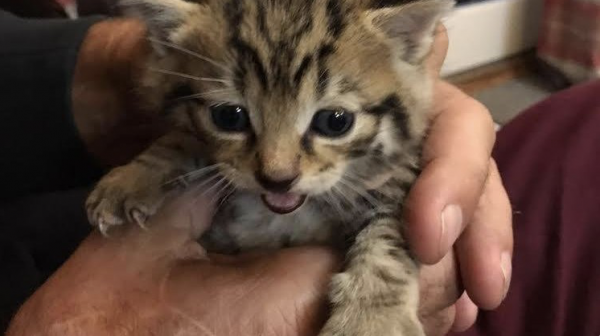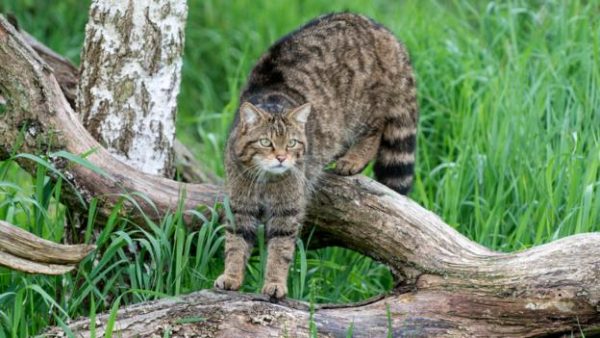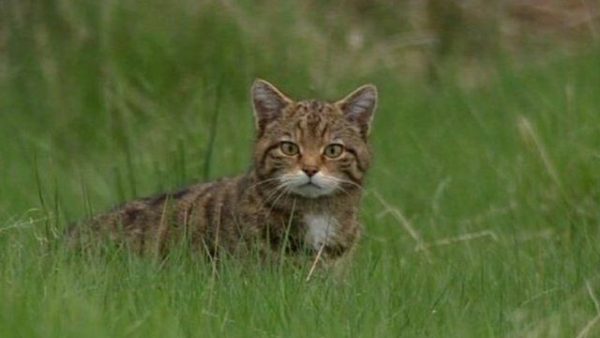
Scottish Wildcat: Conservation and Threats
The Scottish wildcat, a subspecies of the European wildcat, is a critically endangered species native to the Scottish Highlands. Known for its distinctive appearance and elusive nature, this wild feline is now facing multiple threats, such as habitat loss, hybridization with domestic cats, and road accidents. As the population dwindles, conservation efforts are being implemented to protect and restore the numbers of these beautiful creatures.
Often referred to as the “Highland tiger,” the Scottish wildcat is characterized by its bushy tail, striped coat, and robust build. They are skillful hunters, employing a solitary, stealthy approach to catch their prey. They tend to be highly territorial and exhibit a more aggressive behavior compared to their domestic counterparts. Scottish wildcats inhabit dense woodlands, moorlands, and grasslands, where they can find ample food and shelter.
Breeding and mating season for the Scottish wildcat typically occurs in early spring, with a short gestation period resulting in litters of one to seven kittens. Diet-wise, these felines primarily consume small mammals, especially rabbits and voles. As the species faces extinction, a combination of community involvement, habitat restoration, and captive breeding programs aim to ensure the survival and growth of the remaining wildcat population.
Key Takeaways
- The Scottish wildcat is a critically endangered species native to the Scottish Highlands.
- These elusive felines have distinctive physical characteristics and exhibit solitary, territorial behavior.
- Conservation efforts, including habitat restoration and captive breeding programs, are crucial for the survival and growth of the remaining population.
Scottish Wildcat Species Overview
Felis Silvestris Silvestris
The Scottish wildcat, or Felis silvestris silvestris, is a unique and elusive subspecies of wildcat that can be found in Scotland. This secretive carnivore is a member of the Felidae family, which also includes big cats like lions and tigers as well as domesticated felines.
Characterized by their distinctive coat patterns and robust build, Scottish wildcats are considered one of the rarest and most endangered animals in the United Kingdom. Their population has been threatened by habitat loss, persecution, and most critically, hybridization with domestic cats. As a result, the current status of the Scottish wildcat is troubling, with some experts even considering it functionally extinct since 2018.
Efforts to conserve and reintroduce the Scottish wildcat are ongoing, aiming to preserve this unique subspecies for future generations. These efforts include research on their population, habitat, and potential threats, as well as strategies to minimize interbreeding with domestic cats.
European Wildcat
The European wildcat, Felis silvestris, is a separate species of wildcat found primarily in continental Europe. Like their Scottish counterparts, European wildcats are carnivorous members of the Felidae family, but they are not currently facing the same level of threat as Scottish wildcats.
Although some populations of European wildcats have faced similar issues related to habitat loss and hybridization with domestic cats, their numbers are generally more stable across their broader geographical range. This has allowed European wildcats to maintain their status as a distinct species separate from Felis silvestris silvestris.
In order to better understand and protect these enigmatic carnivores, continued research and proactive conservation efforts are crucial for both Scottish and European wildcat populations. This involves collaborative measures between different countries and organizations to ensure the survival of these unique and captivating species.
Scottish Wildcat Physical Characteristics
Size
The Scottish wildcat (Felis silvestris grampia) is a medium-sized carnivore, slightly larger than a domestic cat. Adult males typically weigh between 6-7 kg, while females are lighter, weighing around 4-5 kg. The body length of a wildcat ranges from 50-75 cm, with a tail length of approximately 25-40 cm. This robust size, combined with muscular limbs and broad torsos, sets them apart from their domestic counterparts.
Markings
A distinguishing feature of the Scottish wildcat is its unique pelage, or coat markings. The base color of the fur is usually brownish-gray, with a blend of various darker tones creating intricate patterns. These distinctive markings serve as effective camouflage, enabling them to blend into the Scottish landscape.
Stripes
Broad, bold stripes are present on the dorsal side of the Scottish wildcat, running from its neck down to its tail. These stripes often break up into parallel bands, forming longitudinal streaks. Stripes also occur on the limbs, appearing as horizontal bars or rings.
Spots
The wildcat’s coat has a broken tabby pattern, featuring numerous small spots on its flanks. Some spots may even merge to form short, irregular stripes arranged in vertical or horizontal rows. The pattern is highly variable, making it difficult to establish a definitive wildcat pelage.
Black Tip
One distinguishing characteristic of the Scottish wildcat is the black tip on the tail end. The tail itself is typically thick and bushy, with distinct rings throughout its length that become increasingly thicker and darker toward the tip. The final black tip is a sharp contrast to the general coat marking and serves as a useful identifying feature.
Scottish Wildcat Habitat and Behavior
Range
The Scottish Wildcat is native to Scotland and can be found in various regions throughout the country. Their range has decreased over time due to habitat loss and other factors, but they still maintain a presence in certain areas.
Habitat
Scottish Wildcats primarily inhabit moorland and cairn areas, where they find cover and prey. The presence of grassland habitats is also positively associated with wildcat records, as these areas are home to rabbits – a common prey species for the wildcats. Habitat loss has been one of the main reasons for the decline in wildcat populations, as it results in more fragmented and isolated territories.
Territories
Wildcats are territorial creatures, and they establish their home ranges by marking them with scent, vocalizations, and physical signs like scratching posts. The size of a wildcat’s territory varies depending on the availability of food and shelter, but it typically spans several square kilometers.
Solitary
These wildcats are solitary animals, with each individual living and hunting independently. They usually avoid interactions with other wildcats unless it’s mating season or a mother raising her kittens. This solitary behavior makes estimating their population numbers more challenging.
Active
Scottish Wildcats are most active during the dawn and dusk hours, referred to as crepuscular animals. During these times, they search for food, patrol their territory, and maintain their home ranges. They are known to be skilled hunters, focusing primarily on small mammals like rabbits, but can also feed on birds and other small prey if necessary.

Scottish Wildcat Breeding and Mating
Mating
Scottish Wildcats typically have a specific breeding season which occurs during the early part of the year. Mating between these wild-living cats generally occurs between January and March, but successful mating can be influenced by various factors such as age, health, and territory. Wildcats in captivity have been known to produce litters during the summer months, suggesting that breeding might differ from their wild counterparts. Interbreeding with domestic cats is a concern for the preservation of the purebred Scottish Wildcat population, as it can lead to a reduction in genetic diversity and weaken the species as a whole.
Gestation Period
The gestation period for Scottish Wildcats is approximately 63 to 68 days. After successful mating, female wildcats give birth to a litter of kittens, with an average litter size of three to four kittens. These kittens are born in dens, which can be located in various types of sheltered environments such as thickets, rock crevices, or even abandoned buildings.
Kittens typically open their eyes after about 10 days, and they begin to explore their surroundings shortly thereafter. They start eating solid food at around five weeks old and are usually weaned by eight weeks. Sexual maturity in Scottish Wildcats is reached at approximately one year of age for both males and females, though this can vary depending on individual growth and environmental factors.
Diet
Hunting
The Scottish Wildcat, a solitary and elusive predator, has a natural hunting instinct that drives it to pursue a variety of prey. Its agility, stealth, and keen senses enable it to successfully track and catch small mammals and birds. Wildcats primarily hunt during dawn and dusk, taking advantage of low light conditions to conceal their movements. Occasionally, they also hunt during daytime if the opportunity arises.
Prey
The diet of the Scottish Wildcat consists primarily of small mammals, such as:
- Rabbits: As a significant part of their diet, rabbits provide a necessary calorie and protein source for the wildcat.
- Rodents: A variety of rodents, including mice and voles, contribute to the nutritional needs of the wildcat. Field voles, in particular, are a crucial prey species for the Scottish Wildcat.
- Birds: Though less common in their diet, wildcats occasionally prey on birds as an additional food source.
The diverse diet of the Scottish Wildcat allows it to adapt to changes in prey availability and maintain a healthy and sustainable population.
Scottish Wildcat Threats and Challenges
Hybridisation
One of the primary threats to the Scottish wildcat population is hybridisation with domestic cats. Introgressive hybridisation with domestic cats poses a significant challenge to maintaining the genetic integrity of the wildcat population in Scotland. The presence of hybrids increases the probability of occupying much of the same habitat as wildcats, which further exacerbates the hybridisation threat.
Diseases
Diseases and pathogens, many of which may be transmitted by domestic and feral cats, also pose a significant threat to the Scottish wildcat population. The transmission of diseases can have detrimental effects on the overall health and survival of the wildcats.
FIV
Feline immunodeficiency virus (FIV) is one specific disease that poses a threat to the Scottish wildcat population. FIV is primarily transmitted through contact with other infected cats, including domestic and feral cats. If infected, wildcats may experience a weakened immune system, which can ultimately lead to a decline in the population.
Persecution
Direct persecution, often in the form of shooting by gamekeepers and other land managers, remains a serious issue for the Scottish wildcat. Even though legal protections are in place, hundreds of wild-living cats are killed annually. These deaths can significantly impact the survival and conservation of the Scottish wildcat population, adding further challenges to their recovery efforts.
Scottish Wildcat Conservation Efforts
Several organizations and groups are actively working to conserve and protect the Scottish wildcat.

WildCat Haven
- Wildcat Haven has secured over 1000 square miles of safe habitat for the Scottish wildcat on the Ardnamurchan peninsula. They have done this by humanely trapping feral cats, neutering them and releasing them. This has required large scale community involvement for a period of time extending to over 10 years.
- Large wildcat monitoring site in the Clashindarroch forest in Aberdeenshire.
- Neutering programme for all feral cats and low-grade hybrids.All cats neutered in the area have been cleared of feline diseases.
- Protected the area and created a feral cat buffer zone.
- Ongoing research and local school education programme.
- Achieved widespread support in the local community.
Other prominent initiatives is Scottish Wildcat Action which focuses on preventing the extinction of wildcats in Scotland through various strategies. Additional key stakeholders include Scottish Natural Heritage (now NatureScot), the Royal Zoological Society of Scotland, and the Cairngorms National Park Authority. These groups collaborate to ensure a cohesive approach to the conservation of this threatened species.
Conservation Breeding
Conservation breeding is an essential aspect of efforts to save the Scottish wildcat. The Royal Zoological Society of Scotland operates a captive breeding program to preserve the genetic diversity of the species and potentially create a source of individuals for future reintroductions. Moreover, the Scottish wildcat has been classified as a Priority Species under the UK Biodiversity Action Plan. Consequently, multiple projects are being implemented by the aforementioned organizations to support wild populations, such as improving habitat quality and creating prey-rich environments.
Legislation
Scottish wildcats are granted legal protection through the Wildlife and Countryside Act 1981. Under this act, it is an offence to intentionally kill, injure, or take a wildcat while residing in protected areas. This legislation helps to ensure the safety of wildcats and contribute to their conservation. Additionally, the Scottish Natural Heritage (now NatureScot) works alongside other organizations to enforce these laws while also maintaining biodiversity and contributing to the overall welfare of the species.
In summary, multiple approaches are being utilized to address the conservation needs of the Scottish wildcat, including the work of various conservation groups, captive breeding programs, and the implementation of legal protections. These efforts aim to halt the decline of wildcat populations and hopefully secure their future in the Scottish landscape.
Sighting and Identification
Sighting
The elusive Scottish wildcat (Felis silvestris silvestris) can be challenging to identify due to its similarities with feral and domestic cats. Sightings of these rare animals predominantly occur in rural areas where there is a lower risk of hybridization with domestic cats. Camera trapping has been used as an effective method for monitoring the Scottish wildcat population, primarily focusing on morphological differences between wildcats and their domestic counterparts. Estate staff members and chance sightings by the public have also been beneficial in gathering information on the occurrence and distribution of wildcats in Scotland.
Scottish Wildcat Poop
In addition to visual sightings, scat analysis is another approach for identifying the presence of wildcats in a specific area. Scat can provide valuable information about the diet, habitat preferences, and territory boundaries of the Scottish wildcat. By collecting and analyzing scat, researchers can gain a better understanding of the environmental factors that may influence wildcat populations.
Here are some characteristics of wildcat scat:
- Shape: cylindrical, usually twisted at one or both ends
- Size: length varies between 4 to 8 cm, with a diameter of approximately 1 to 1.5 cm
- Content: often contains fur, bone fragments, and feathers from prey
- Rings: distinctive rings may be visible in some scat samples, indicative of wildcat territory markers.
It is important to note that wildcat scat shares similarities with the scat of other species, such as foxes and domestic cats, making positive identification challenging. Nonetheless, scat analysis, in conjunction with sightings and camera trapping, offers a more comprehensive understanding of the elusive Scottish wildcat’s distribution and population status.
Scottish Wildcats in Popular Culture
The Scottish wildcat, commonly known as the “Highland Tiger,” has become an emblem of Scottish wildlife and heritage. This elusive and mysterious creature has been featured in various forms of media, ranging from literature and documentaries to local legends and folklore.
Scotland’s highland landscapes, such as Ardnamurchan and Clashindarroch Forest, are ideal habitats for the Scottish wildcat. These regions have not only provided protection for the wildcats but have also inspired many tales and myths of the “Highland Tiger” living in their midst. In these stories, the wildcat is often depicted as a symbol of strength, independence, and resilience.
Conservation efforts have been underway to preserve the remaining populations of Scottish wildcats. One such initiative is the Wildcat Haven, which focuses on creating a protected environment for wildcats to thrive in areas such as Ardnamurchan. The goal of these efforts is to prevent the extinction of this iconic species and maintain their place in Scottish culture.
In contemporary times, the Scottish wildcat has garnered attention in documentaries and news articles, highlighting their current conservation status and the various challenges they face. As public awareness grows, concern for the survival of the “Highland Tiger” has resulted in an increase in support for conservation projects and legislation to protect the species.
By continuing to maintain interest and awareness of the Scottish wildcat in popular culture, the importance of preserving this unique and iconic creature can be emphasized, ensuring that future generations can appreciate the heritage and beauty of the “Highland Tiger” in the wild landscapes of Scotland.

Frequently Asked Questions
What is the diet of the Scottish wildcat?
The diet of the Scottish wildcat primarily consists of small mammals, such as mice, voles, and rabbits. They are obligate carnivores, relying solely on animal-based food sources for their nutritional needs. Occasionally, they may also hunt birds and other small animals.
Where can Scottish wildcats be found?
Scottish wildcats are native to Scotland, predominantly found in woodland areas and open grasslands. Their preferred habitats include dense undergrowth and areas with plenty of cover for hunting, such as forests or moorlands. According to the Scottish Wildcat Conservation Action Plan, efforts are being made to improve the conservation status of the wildcat in Scotland.
How many Scottish wildcats are left in 2023?
It is challenging to estimate the exact number of Scottish wildcats remaining in the wild due to their elusive nature and the difficulty in distinguishing between pure wildcats and hybrid individuals. However, it’s believed that their population is critically low, with estimates ranging between a few dozen to a few hundred individuals.
What is their scientific name?
The scientific name for the Scottish wildcat is Felis silvestris grampia. It is a subspecies of the European wildcat (Felis silvestris) and is unique to Scotland.
Are they larger than domestic cats?
Scottish wildcats are generally larger than domestic cats, with longer legs and a more robust build. Males tend to be larger than females, with an average length of around 90 centimeters (including their tails) and weighing up to 8 kilograms. Additionally, wildcats have distinct markings, such as broad stripes on their flank and a bushy tail with a black tip.
Why are they endangered?
The main threats to the Scottish wildcat’s survival include habitat loss, persecution, and hybridization with domestic cats. Over the years, deforestation and agricultural expansion have led to a decrease in suitable habitats, while persecution from gamekeepers and farmers has also contributed to their declining population. The increase in hybridization with domestic cats has further diluted their gene pool, making it challenging to conserve the remaining pure Scottish wildcat population.